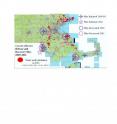UMass Amherst entomologists begin to control winter moth infestation in eastern Massachusetts
A six-year campaign to control invasive winter moths with a natural parasite led by entomologist Joe Elkinton of the University of Massachusetts Amherst now has concrete evidence that a parasitic fly, Cyzenis albicans, has been established and is attacking the pest at four sites in Seekonk, Hingham, Falmouth and Wellesley. It's the beginning of the end for the decade-long defoliation of eastern Massachusetts trees by the invasive species, Elkinton says. The researchers marked an important milestone during field work this summer and last, when they recovered winter moth larvae recently parasitized by C. albicans, the parasitic fly, at sites in the four towns. The evidence indicates that the flies had successfully overwintered and are now actively preying on the moth's young.
The winter moth, Operophtera brumata, invaded the state from Europe more than a decade ago and has caused widespread, damaging defoliation of many deciduous tree species. The moths have moved westward and recently spread to Rhode Island. In many of these areas defoliation has occurred almost every year since the infestation began. As a result, many trees have started to die. Similar winter moth invasions occurred in Nova Scotia in the 1950s and in the Pacific northwest in the 1970s. In each case, outbreaks were permanently controlled by introducing C. albicans, Elkinton adds.
"Because C. albicans was so successful in controlling winter moth in Nova Scotia and the Pacific northwest, it was natural for us to introduce it here in New England using flies my colleagues and I collected in British Columbia," he notes.
A great advantage of C. albicans is that it is highly specialized to prey on winter moths, so it does not spread to other species. Further, its numbers decline once it gains control, the entomologist points out. It is not attracted to humans or our homes and buildings, so the only impact people will notice is the decline in tree damage.
The researchers have conducted DNA tests that prove the flies recovered in 2010 and 2011 are identical to those they released. "Our experience now matches closely the Nova Scotia project wherein the yearly releases began in 1954, but no recoveries at all were made until 1959. Previous experience in Nova Scotia or British Columbia suggests that the levels of parasitism should now build rapidly in eastern Massachusetts over the next few years," Elkinton says.
"Now that we know that single releases with a few hundred flies can result in establishment here in New England, we can spread the flies we have to more new sites." He and his team have now released about 700 flies at each of nine new sites in 2011, including one in Rhode Island.
They also collected 61,000 winter moth pupae that contain C. albicans larva in British Columbia and have sequestered them in the USDA quarantine lab at Otis Air Force Base for release next year in Massachusetts. "Previous experience tells us that about 50 percent of these pupae will contain immature C. albicans. Assuming that we can successfully rear most of these to the adult stage next spring, by May 2012 we should have more flies to release than ever before," says Elkinton.
The UMass Amherst winter moth control project was begun in 2005 with support from the Massachusetts Legislature, and later the USDA and the Massachusetts Department of Conservation and Recreation. Though budget cutbacks threaten to slow progress, Elkinton is hopeful that efforts will continue to release flies at new locations, because it takes time for only a few thousand flies to catch up with the estimated trillions of winter moths now munching their way across eastern and central Massachusetts.
Recommend this story on Facebook, Twitter,
and Google +1:
Source: University of Massachusetts at Amherst
Other sources
- Entomologists begin to control winter moth infestation in eastern Massachusettsfrom Science DailyWed, 7 Sep 2011, 23:30:40 UTC
- Entomologists begin to control winter moth infestation in eastern Massachusettsfrom PhysorgWed, 7 Sep 2011, 21:00:32 UTC
- Controlling Winter Moth Infestation in New Englandfrom Newswise - ScinewsWed, 7 Sep 2011, 20:31:43 UTC
